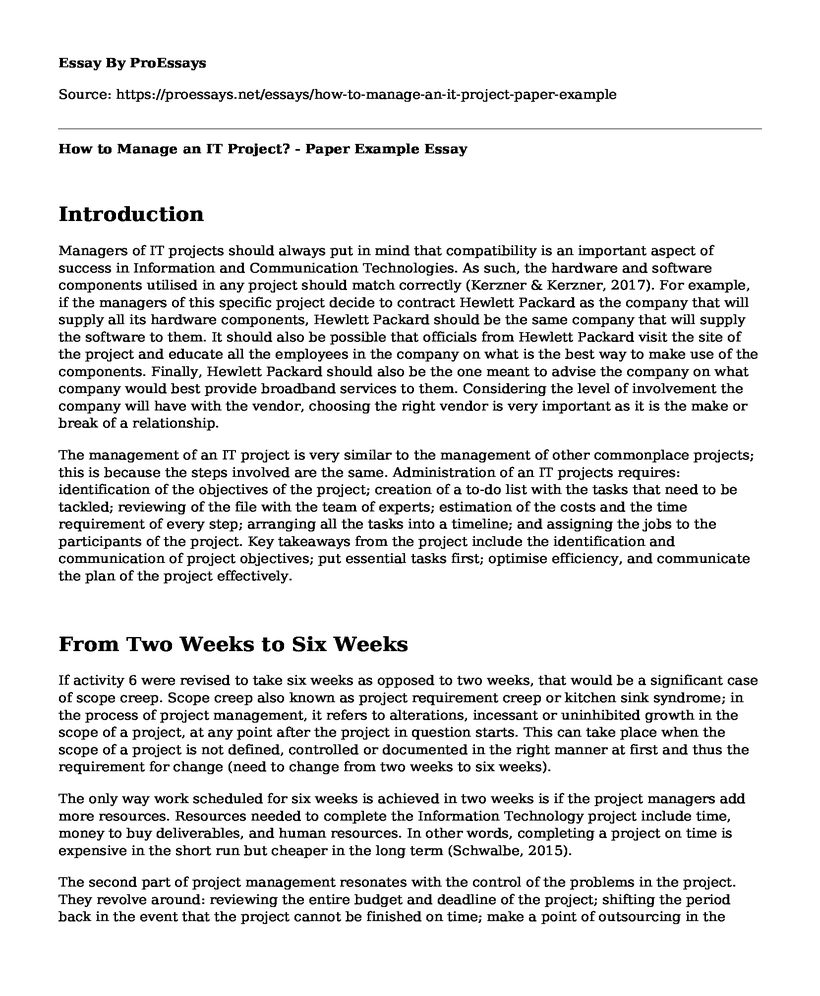Introduction
Managers of IT projects should always put in mind that compatibility is an important aspect of success in Information and Communication Technologies. As such, the hardware and software components utilised in any project should match correctly (Kerzner & Kerzner, 2017). For example, if the managers of this specific project decide to contract Hewlett Packard as the company that will supply all its hardware components, Hewlett Packard should be the same company that will supply the software to them. It should also be possible that officials from Hewlett Packard visit the site of the project and educate all the employees in the company on what is the best way to make use of the components. Finally, Hewlett Packard should also be the one meant to advise the company on what company would best provide broadband services to them. Considering the level of involvement the company will have with the vendor, choosing the right vendor is very important as it is the make or break of a relationship.
The management of an IT project is very similar to the management of other commonplace projects; this is because the steps involved are the same. Administration of an IT projects requires: identification of the objectives of the project; creation of a to-do list with the tasks that need to be tackled; reviewing of the file with the team of experts; estimation of the costs and the time requirement of every step; arranging all the tasks into a timeline; and assigning the jobs to the participants of the project. Key takeaways from the project include the identification and communication of project objectives; put essential tasks first; optimise efficiency, and communicate the plan of the project effectively.
From Two Weeks to Six Weeks
If activity 6 were revised to take six weeks as opposed to two weeks, that would be a significant case of scope creep. Scope creep also known as project requirement creep or kitchen sink syndrome; in the process of project management, it refers to alterations, incessant or uninhibited growth in the scope of a project, at any point after the project in question starts. This can take place when the scope of a project is not defined, controlled or documented in the right manner at first and thus the requirement for change (need to change from two weeks to six weeks).
The only way work scheduled for six weeks is achieved in two weeks is if the project managers add more resources. Resources needed to complete the Information Technology project include time, money to buy deliverables, and human resources. In other words, completing a project on time is expensive in the short run but cheaper in the long term (Schwalbe, 2015).
The second part of project management resonates with the control of the problems in the project. They revolve around: reviewing the entire budget and deadline of the project; shifting the period back in the event that the project cannot be finished on time; make a point of outsourcing in the event that the IT Project needs to be finished on a much earlier date; eliminating a number of steps so that the project can be completed much earlier; and making a decision on how to go about worst case scenarios (Kerzner & Kerzner, 2017).
Overall, the practical aspect of conducting the IT project resonates with: convention of a kickoff meeting to start the scheme of the company; stay connected to the team members to monitor the progress of the project; keep all the stakeholders posted on the progression of the project; adjust the plan as required to get the work completed in the best time possible; going through the project and learning from what happened (Schwalbe, 2015).
Earliest Expected Completion Time
Optimistic time is the earliest expected completion time of a project (Kerzner & Kerzner, 2017). The earliest expected completion time of the project is 44 (3+2+2+6+3+2+4+5+7+2=44) days. The forty-four days stem from the addition of the time estimates made before the initial capital outlay of the project. Even though the timely completion of a project is essential there is a need for all the stakeholders not to rush the project through as that may compromise the quality of the work done.
Gantt Chart
In the Gantt Chart above, the time taken to complete every project phase is essential and is indicated. Note that the longer the stripes in the Gantt Chart, the longer the time taken to achieve a specific activity of the project.
References
Kerzner, H., & Kerzner, H. R. (2017). Project management: a systems approach to planning, scheduling, and controlling. John Wiley & Sons.
Schwalbe, K. (2015). Information technology project management. Cengage Learning
Cite this page
How to Manage an IT Project? - Paper Example. (2022, Jun 05). Retrieved from https://proessays.net/essays/how-to-manage-an-it-project-paper-example
If you are the original author of this essay and no longer wish to have it published on the ProEssays website, please click below to request its removal:
- The Interview Questionnaire Example
- Production and Cost Analysis
- Consequences of Not Implementing the Change in Acme Inc Essay
- Essay on Effective Corporate Governance: Transparency, Accountability and Risk Management
- Organizational Culture: Maslow's Hierarchy of Needs for Employee Motivation - Essay Sample
- Essay on Adapting to Ambiguity: Opportunities & Dangers of Tech & Revolutions
- Effective INT Data Collection: Improving Skills to Categorize PIRs - Essay Sample







